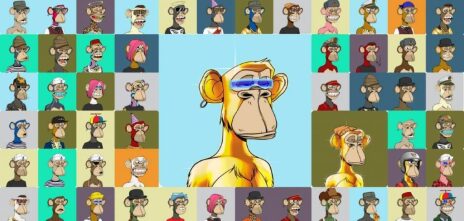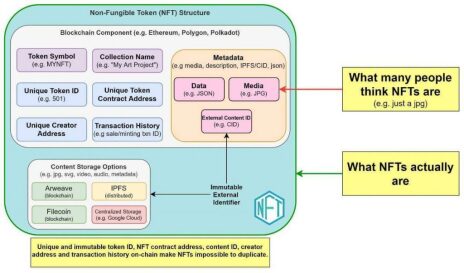First off, what are NFTs? NFT is an acronym for non-fungible token, which we’ll dive into after discussing some of the recent headlines. Regardless of your interests, you’ve probably read some news recently about high-profile purchases of NFTs.
NBA star Stephen Curry recently purchased one for approximately $180,000. He joins the ranks of numerous other athletes, celebrities, musicians, influencers and, increasingly, brands (both Visa and the maker of Arizona Iced Tea) making large investments in the space. In fact, starting today, and lasting for the next week, you’ll see this image on the website of Sotheby’s Auction House.
*Source Sothebys.com
That image represents a portion of a digital collection of 101 Bored Ape Yacht Club NFTs that are expected to fetch $12-18MM at auction. That may seem like a significant amount of money to spend on cartoon ape pictures, but it represents a small fraction of the estimated $50 billion global art market.
[text_ad]
And it’s still a nascent market; NFTs currently account for only $25 billion of the roughly $2 trillion cryptocurrency circulation.
Technically Speaking, What are NFTs?
The NFTs themselves can be any type of digital media whose ownership is recorded to the underlying cryptocurrency blockchain. The most popular are currently using Ethereum, but other cryptocurrencies have their own NFT adopters. This recorded ownership is validated by the network during initial creation and any subsequent transfers. Non-fungible means you have a unique digital asset that is the only version of itself, it could be one-of-one, or one of a series of 50, but the digital identifiers make it unique.
Think of it as digital provenance that is agreed upon by an entire decentralized network of users. This provenance is of particular value in the art collecting space (it’s also why saving a copy of the image isn’t remotely the same as owning the original). The following graphic, from @RealAllenHena, provides a useful visualization of that difference.
An iceberg is a useful analogy for an NFT. The picture you see on your phone or computer is the tip of the iceberg visible above the water but the substance of the NFT is what’s hiding beneath.
What are NFTs Good for?
The cartoon ape pictures above are currently the most popular type of NFT. They’re categorized as PFP (profile picture) NFTs that serve as a digital status symbol and offer membership to a community. By buying one, you’re gaining access to an exclusive club (10,000 is a fairly typical count for PFP projects).
The value of that membership is the primary driver of the cost of admission. Anyone can put a picture of an ape online, but only 10,000 people can say they’re part of the same club as famous athletes and musicians.
There are lots of NFT communities out there and all have a different approach to giving value to their members, some share revenue, support charitable causes or create branded content. In fact, the creators of the Bored Ape Yacht Club (pictured above) recently signed with a Hollywood talent agency.
Most NFT developers also offer commercial rights to the NFT you purchase, so you could even license it out.
Generative art and digital art are also popular types of NFTs. Those are more akin to traditional art collecting in that the value is derived from aesthetics and exclusivity. Generative art is typically produced programmatically in limited runs while digital art is frequently created by an artist or photographer and may be only a single piece.
You may be wondering, what are NFTs going to do in the future? Well, given the early promise it’s hard to say (think of the internet in the ‘90s). They could offer you access to virtual clubs, serve as event tickets, offer partial ownership in a professional athlete’s career, allow you to easily earn money by playing a video game—the possibilities are nearly endless.
Importantly though, blockchain technology offers the possibility for users to own (and profit from) their digital presence, as opposed to current internet technologies like Facebook and Twitter where companies profit from their users.
Now, what are NFTs’ downsides? As mentioned above, this is very reminiscent of the early days of the internet, and 90%+ of NFT projects will likely fail and crash. The barrier to entry is also high for new participants in the space. You need to buy cryptocurrency and set up a digital wallet before you can even start shopping for an NFT. If you’re using OpenSea, one of the most rapidly growing marketplaces, you’re also going to face high transaction fees because of how it proves ownership.
If you’re buying an NFT you shouldn’t invest more than you’re willing to lose and you should consider putting small amounts in different projects that either have mission statements that align with your values or whose art speaks to you, something that, even if it became worthless, you’d be happy to own.
Have you considered trying to buy NFTs or have you purchased them? Why or why not?
[author_ad]


